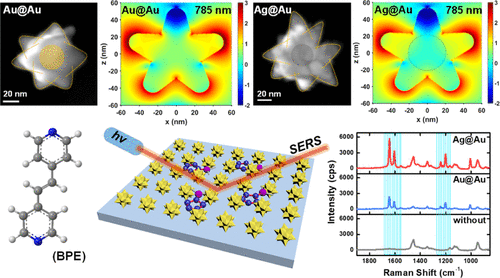当前位置:
X-MOL 学术
›
ACS Appl. Nano Mater.
›
论文详情
Our official English website, www.x-mol.net, welcomes your
feedback! (Note: you will need to create a separate account there.)
Bimetallic Core–Shell Nanostars with Tunable Surface Plasmon Resonance for Surface-Enhanced Raman Scattering
ACS Applied Nano Materials ( IF 5.3 ) Pub Date : 2020-11-05 , DOI: 10.1021/acsanm.0c02144 Jinming Ma 1 , Xiangfu Liu 1 , Rongwen Wang 1 , Jibin Zhang 1 , Pengfei Jiang 1 , Yao Wang 1 , Guoli Tu 1
ACS Applied Nano Materials ( IF 5.3 ) Pub Date : 2020-11-05 , DOI: 10.1021/acsanm.0c02144 Jinming Ma 1 , Xiangfu Liu 1 , Rongwen Wang 1 , Jibin Zhang 1 , Pengfei Jiang 1 , Yao Wang 1 , Guoli Tu 1
Affiliation

|
Noble metal complex nanomaterials were widely investigated in bioscientific systems for surface-enhanced Raman scattering (SERS) imaging. Silver (Ag) has higher enhancement factors, arising from better optical properties, in comparison to gold (Au), which has better chemical stability and a broader localized surface plasmon resonance (LSPR) region extending to red-NIR, and both should be taken into account to enhance SERS performance. Among them, nanostars (NSs) have emerged as one promising geometry because of their strong enhanced electromagnetic fields induced by the lightning-rod effect from their branches. Therefore, core–shell NSs have been employed as efficient SERS substrates for trace detection because bimetallic nanoparticles provide richer plasmonic modes from their integrated material-dependent and size/shape-correlated plasmonics. Herein, we prepared two uniform and tunable core–shell NSs with different cores (Ag or Au) and the same Au shell, tailoring size and branch morphology to investigate their induced LSPR properties. As a result, their extinction spectra nearly coincide when the size and shape of two NSs become similar. A parallel electric field distribution and response wavelength were obtained as the shells are alike. Thus, it strongly suggests that the shell dominates its LSPR region in the core–shell NS. Meanwhile, an improved SERS activity with an enhancement factor of 1.5 × 107 was achieved in Ag@Au compared to Au@Au NSs because of the addition of Ag. This work offered certain theoretical and experimental references for the plasmonic metal NS with extensively enhanced electromagnetic fields, providing an effective SERS substrate for imaging and detection in life sciences.
中文翻译:

具有可调谐表面等离子体共振的双金属核-壳纳米星,用于表面增强拉曼散射
在用于表面增强拉曼散射(SERS)成像的生物科学系统中,对贵金属络合物纳米材料进行了广泛研究。与金(Au)相比,银(Ag)具有更高的增强因子,这归因于更好的光学性能,而金(Au)具有更好的化学稳定性和更宽的局部表面等离振子共振(LSPR)区域,并延伸至红色-NIR。考虑到增强SERS性能。其中,由于由分支的避雷针效应引起的电磁场增强,纳米星(NSs)成为一种有前途的几何形状。因此,核壳型NS被用作痕量检测的有效SERS底物,因为双金属纳米颗粒从其综合的材料依赖性和尺寸/形状相关的等离激元提供了更丰富的等离激元模式。在本文中,我们准备了两个具有不同核(Ag或Au)和相同Au壳的均匀且可调的核壳NS,调整了大小和分支形态以研究其诱导的LSPR特性。结果,当两个NS的大小和形状变得相似时,它们的消光光谱几乎重合。当壳相似时,获得平行的电场分布和响应波长。因此,它强烈表明壳在核壳NS中占据了它的LSPR区。同时,SERS活性得到改善,增强因子为1.5×10 当两个NS的大小和形状相似时,它们的消光光谱几乎重合。当壳相似时,获得平行的电场分布和响应波长。因此,它强烈表明壳在核壳NS中占据了它的LSPR区。同时,SERS活性得到改善,增强因子为1.5×10 当两个NS的大小和形状相似时,它们的消光光谱几乎重合。当壳相似时,获得平行的电场分布和响应波长。因此,它强烈表明壳在核壳NS中占据了它的LSPR区。同时,SERS活性得到改善,增强因子为1.5×10由于添加了Ag,与Au @ Au NSs相比,Ag @ Au中达到了7。这项工作为具有广泛增强的电磁场的等离激元金属NS提供了某些理论和实验参考,为生命科学中的成像和检测提供了有效的SERS基质。
更新日期:2020-11-05
中文翻译:

具有可调谐表面等离子体共振的双金属核-壳纳米星,用于表面增强拉曼散射
在用于表面增强拉曼散射(SERS)成像的生物科学系统中,对贵金属络合物纳米材料进行了广泛研究。与金(Au)相比,银(Ag)具有更高的增强因子,这归因于更好的光学性能,而金(Au)具有更好的化学稳定性和更宽的局部表面等离振子共振(LSPR)区域,并延伸至红色-NIR。考虑到增强SERS性能。其中,由于由分支的避雷针效应引起的电磁场增强,纳米星(NSs)成为一种有前途的几何形状。因此,核壳型NS被用作痕量检测的有效SERS底物,因为双金属纳米颗粒从其综合的材料依赖性和尺寸/形状相关的等离激元提供了更丰富的等离激元模式。在本文中,我们准备了两个具有不同核(Ag或Au)和相同Au壳的均匀且可调的核壳NS,调整了大小和分支形态以研究其诱导的LSPR特性。结果,当两个NS的大小和形状变得相似时,它们的消光光谱几乎重合。当壳相似时,获得平行的电场分布和响应波长。因此,它强烈表明壳在核壳NS中占据了它的LSPR区。同时,SERS活性得到改善,增强因子为1.5×10 当两个NS的大小和形状相似时,它们的消光光谱几乎重合。当壳相似时,获得平行的电场分布和响应波长。因此,它强烈表明壳在核壳NS中占据了它的LSPR区。同时,SERS活性得到改善,增强因子为1.5×10 当两个NS的大小和形状相似时,它们的消光光谱几乎重合。当壳相似时,获得平行的电场分布和响应波长。因此,它强烈表明壳在核壳NS中占据了它的LSPR区。同时,SERS活性得到改善,增强因子为1.5×10由于添加了Ag,与Au @ Au NSs相比,Ag @ Au中达到了7。这项工作为具有广泛增强的电磁场的等离激元金属NS提供了某些理论和实验参考,为生命科学中的成像和检测提供了有效的SERS基质。











































 京公网安备 11010802027423号
京公网安备 11010802027423号